Sustainability and Brand Equity: The Moderating Role of Brand Color and Brand Gender
Abstract
1. Introduction
2. Literature Review and Hypotheses
2.1. Brand Color
2.2. Brand Gender
2.3. Sustainability, Perceived Quality and Brand Equity
2.3.1. Sustainability
2.3.2. Perceived Quality
2.3.3. Brand Equity
3. Study 1
3.1. Materials and Methodology
3.2. Results
4. Study 2
4.1. Materials and Methodology
4.1.1. Participants
4.1.2. Manipulation Checks
4.1.3. Procedure and Materials
4.2. Results
4.2.1. Discriminant Validity
4.2.2. Mediation
4.2.3. Moderated Mediation
5. Discussion and Conclusions
6. Limitations and Directions for Future Research
Author Contributions
Funding
Institutional Review Board Statement
Informed Consent Statement
Data Availability Statement
Conflicts of Interest
References
- Singh:, S. Impact of color on marketing. Manag. Decis. 2006, 44, 783–789. [Google Scholar] [CrossRef]
- Labrecque, L.I.; Milne, G.R. Exciting red and competent blue: The importance of color in marketing. J. Acad. Mark. Sci. 2012, 40, 711–727. [Google Scholar] [CrossRef]
- Labrecque, L.I.; Milne, G.R. To be or not to be different: Exploration of norms and benefits of color differentiation in the marketplace. Mark. Lett. 2013, 24, 165–176. [Google Scholar] [CrossRef]
- Labrecque, L.I.; Patrick, V.M.; Milne, G.R. The Marketers’ Prismatic Palette: A Review of Color Research and Future Directions. Psychol. Mark. 2013, 30, 187–202. [Google Scholar] [CrossRef]
- Kapferer, J.N. Brand confusion: Empirical study of a legal concept. Psychol. Mark. 1995, 12, 551–568. [Google Scholar] [CrossRef]
- Abril, P.S.; Olazábal, A.M.; Cava, A. Marketing and the Law. J. Acad. Mark. Sci. 2009, 37, 375–380. [Google Scholar] [CrossRef]
- Labrecque, L.I. Color research in marketing: Theoretical and technical considerations for conducting rigorous and impactful color research. Psychol. Mark. 2020, 37, 855–863. [Google Scholar] [CrossRef]
- Singh, N.; Srivastava, S.K. Impact of Colors on The Psychology of Marketing—A Comprehensive Over View. Manag. Labour. Stud. 2011, 36, 199–209. [Google Scholar] [CrossRef]
- Baxter, S.M.; Ilicic, J.; Kulczynski, A. Roses are red, violets are blue, sophisticated brands have a Tiffany Hue: The effect of iconic brand color priming on brand personality judgments. J. Brand. Manag. 2018, 25, 384–394. [Google Scholar] [CrossRef]
- Olsen, M.C.; Slotegraaf, R.J.; Chandukala, S.R. Green Claims and Message Frames: How Green New Products Change Brand Attitude. J. Mark. 2014, 78, 119–137. [Google Scholar] [CrossRef]
- Samaraweera, M.; Sims, J.D.; Homsey, D.M. Will a green color and nature images make consumers pay more for a green product? J. Consum. Mark. 2020, 38, 305–312. [Google Scholar] [CrossRef]
- DeLong, M.; Goncu-Berk, G. What Color is Sustainability; Berg Publisher: New York, NY, USA, 2012; pp. 89–104. [Google Scholar]
- White, K.; Hardisty, D.J.; Habib, R. The Elusive Green Consumer. Harv. Bus. Rev. 2019, 11, 124–133. [Google Scholar]
- Olson, E.L. It’s not easy being green: The effects of attribute tradeoffs on green product preference and choice. J. Acad. Mark. Sci. 2013, 41, 171–184. [Google Scholar] [CrossRef]
- Hopkins, M.S.; Roche, C. What the green consumer wants. MIT. Sloan. Manag. Rev. 2009, 50, 87. [Google Scholar]
- Dunham, M. McDonald’s Rolling out Green Logo in Europe. 2009. Available online: https://www.nbcnews.com/id/wbna34111784 (accessed on 10 May 2023).
- Avison, J. McDonald’s Green European Revolution. 2019. Available online: https://theconsumerverse.wordpress.com/2019/10/11/mcdonalds-green-european-revolution/ (accessed on 26 May 2023).
- Ranaweera, A.T.; Wasala, K. Color matters: The Impact of Logo Color on Consumer Perceived Eco-Friendliness. Exp. J. Mark. 2020, 8, 129–139. [Google Scholar]
- Irish Examiner. McDonald’s Gets Profit Boost from Price Rises and Sales in Europe. 2023. Available online: https://www.irishexaminer.com/business/companies/arid-41061092.html (accessed on 26 May 2023).
- Hermès. Eco-Design. Available online: https://finance.hermes.com/en/eco-design/ (accessed on 10 May 2023).
- Stillman, P.; Lee, H.; Deng, X.; Unnava, H.R.; Fujita, K. Examining consumers’ sensory experiences with color: A consumer neuroscience approach. Psychol. Mark. 2020, 37, 995–1007. [Google Scholar] [CrossRef]
- Fairchild, M.D. Color Appearance Models, 2nd ed.; John Wiley & Sons: Hoboken, NJ, USA, 2013; Volume 8, p. 126. [Google Scholar]
- Jin, C.H.; Yoon, M.S.; Lee, J.Y. The influence of brand color identity on brand association and loyalty. J. Prod. Brand. Manag. 2019, 28, 50–62. [Google Scholar] [CrossRef]
- César Machado, J.; Fonseca, B.; Martins, C. Brand logo and brand gender: Examining the effects of natural logo designs and color on brand gender perceptions and affect. J. Brand. Manag. 2021, 28, 152–170. [Google Scholar] [CrossRef]
- Aslam, M.M. Are you selling the right colour? A cross-cultural review of colour as a marketing cue. J. Mark. Commu. 2005, 12, 15–30. [Google Scholar] [CrossRef]
- Sedky, D.; AbdelRaheem, M.A. Studying green marketing in emerging economies. Bus. Stra. Dev. 2022, 5, 59–68. [Google Scholar] [CrossRef]
- Pastoureau, M. Green: The History of a Color; Princeton University Press: Princeton, NJ, USA, 2014; pp. 31–45. [Google Scholar]
- Wikipedia. Green. Available online: https://en.wikipedia.org/wiki/Green (accessed on 9 May 2023).
- Grohmann, B. Gender Dimensions of Brand Personality. J. Mark. Res. 2009, 46, 105–119. [Google Scholar] [CrossRef]
- Aaker, J.L. Dimensions of Brand Personality. J. Mark. Res. 1997, 34, 347–356. [Google Scholar] [CrossRef]
- Lieven, T.; Grohmann, B.; Herrmann, A.; Landwehr, J.R.; van Tilburg, M. The Effect of brand gender on brand equity. Psychol. Mark. 2014, 31, 371–385. [Google Scholar] [CrossRef]
- Sanghi, K. Consumers Are the Key to Taking Green Mainstream. 2022. Available online: https://www.bcg.com/publications/2022/consumers-are-the-key-to-taking-sustainable-products-mainstream (accessed on 9 May 2023).
- Loučanová, E.; Šupín, M.; Čorejová, T.; Repková-štofková, K.; Šupínová, M.; Štofková, Z.; Olšiaková, M. Sustainability and branding: An integrated perspective of eco-innovation and brand. Sustainability 2021, 13, 732. [Google Scholar] [CrossRef]
- Alamsyah, D.P.; Othman, N.A.; Bakri, M.H.; Udjaja, Y.; Aryanto, R. Green awareness through environmental knowledge and perceived quality. Manag. Sci. Lett. 2021, 11, 271–280. [Google Scholar] [CrossRef]
- Borin, N.; Lindsey-Mullikin, J.; Krishnan, R. An analysis of consumer reactions to green strategies. J. Prod. Brand. Manag. 2013, 22, 118–128. [Google Scholar] [CrossRef]
- Milfont, T.L.; Duckitt, J. The environmental attitudes inventory: A valid and reliable measure to assess the structure of environmental attitudes. J. Environ. Psychol. 2010, 30, 80–94. [Google Scholar] [CrossRef]
- Winit, W.; Kantabutra, S.; Kantabutra, S. Toward a Sustainability Brand Model: An Integrative Review. Sustainability 2023, 15, 5212. [Google Scholar] [CrossRef]
- Amatulli, C.; De Angelis, M.; Donato, C. The atypicality of sustainable luxury products. Psychol. Mark. 2021, 38, 1990–2005. [Google Scholar] [CrossRef]
- Sander, F.; Föhl, U.; Walter, N.; Demmer, V. Green or social? An analysis of environmental and social sustainability advertising and its impact on brand personality, credibility and attitude. J. Brand. Manag. 2021, 28, 429–445. [Google Scholar] [CrossRef]
- Kapferer, J.N.; Michaut-Denizeau, A. Are millennials really more sensitive to sustainable luxury? A cross-generational international comparison of sustainability consciousness when buying luxury. J. Brand. Manag. 2020, 27, 35–47. [Google Scholar] [CrossRef]
- Ramaseshan, B.; Tsao, H.-Y. Moderating effects of the brand concept on the relationship between brand personality and perceived quality. J. Brand. Manag. 2007, 14, 458–466. [Google Scholar] [CrossRef]
- Aaker, D.A.; Jacobson, R. The Financial Information Content of Perceived Quality. J. Mark. Res. 1994, 31, 191–201. [Google Scholar] [CrossRef]
- Keller, K.L.; Aaker, D.A. The Effects of Sequential Introduction of Brand Extensions. J. Mark. Res. 1992, 29, 35–50. [Google Scholar] [CrossRef]
- Yoo, B.; Donthu, N.; Lee, S. An examination of selected marketing mix elements and brand equity. J. Acad. Mark. Sci. 2000, 28, 195–211. [Google Scholar] [CrossRef]
- Aaker, D. Aaker on Branding: 20 Principles that Drive Success; Morgan James Publishing: New York, NY, USA, 2014; pp. 133–145. [Google Scholar]
- Raggio, R.D.; Leone, R.P. Chasing brand value: Fully leveraging brand equity to maximise brand value. J. Brand. Manag. 2009, 16, 248–263. [Google Scholar] [CrossRef]
- Keller, K.L.; Swaminathan, V. Strategic Brand Management: Building, Measuring, and Managing Brand Equity, Global, 5th ed.; Pearson: Upper Saddle River, NJ, USA, 2020; p. 70. [Google Scholar]
- Chen, Y.S.; Lin, C.Y.; Weng, C.S. The influence of environmental friendliness on green trust: The mediation effects of green satisfaction and green perceived quality. Sustainability 2015, 7, 10135–10152. [Google Scholar] [CrossRef]
- Interbrand. Best Global Brands 2022. Available online: https://interbrand.com/best-brands/ (accessed on 25 May 2023).
- Sun, M.J.; Kim, J.S. A Study on the Criteria for Choosing Brand Name Type and their Effectiveness—Focused on FCB Grid Model. J. Brand. Des. Assoc. Korea. 2021, 19, 269–282. [Google Scholar]
- Brand Colors and Friends. Brand Colors. Available online: https://brandcolors.net/ (accessed on 10 May 2023).
- Digital Synopsis. Colors Used by Famous Brands. Available online: https://digitalsynopsis.com/design/brand-colors/ (accessed on 26 May 2023).
- Chanel. Chanel Climate Report. Available online: https://www.chanel.com/gb/climate-report/ (accessed on 10 May 2023).
- Louis Vuitton. Our Committed Journey. Available online: https://eu.louisvuitton.com/eng-e1/magazine/articles/sustainability (accessed on 10 May 2023).
- Apple. Apple Environment. 2023. Available online: https://www.apple.com/environment/ (accessed on 10 May 2023).
- World Wildlife Fund. WWF and Apple Pay Help the Planet during Earth Month. 2023. Available online: https://www.worldwildlife.org/stories/wwf-and-apple-pay-help-the-planet-during-earth-month (accessed on 10 May 2023).
- Nike. Move to Zero. Available online: https://www.nike.com/sustainability (accessed on 26 May 2023).
- Lieven, T.; Hildebrand, C. The impact of brand gender on brand equity: Findings from a large-scale cross-cultural study in ten countries. Int. Mark. Rev. 2016, 33, 178–195. [Google Scholar] [CrossRef]
- Baalbaki, S.; Guzmán, F. A consumer-perceived consumer-based brand equity scale. J. Brand. Manag. 2016, 23, 229–251. [Google Scholar] [CrossRef]
- Schmuck, D.; Matthes, J.; Naderer, B. Misleading Consumers with Green Advertising? An Affect–Reason–Involvement Account of Greenwashing Effects in Environmental Advertising. J. Advert. 2018, 47, 127–145. [Google Scholar] [CrossRef]
- Fornell, C.; Larcker, D.F. Structural equation models with unobservable variables and measurement error: Algebra and statistics. J. Mark. Res. 1981, 18, 382–388. [Google Scholar] [CrossRef]
- Hayes, A.F. Introduction to Mediation, Moderation, and Conditional Process Analysis: A Regression-Based Approach; Guilford Publications: New York, NY, USA, 2017; pp. 145–310. [Google Scholar]
- Aiken, L.S.; West, S.G. Multiple Regression: Testing and Interpreting Interactions; SAGE: Thousand Oaks, CA, USA, 1991; p. 212. [Google Scholar]
- Pancer, E.; McShane, L.; Noseworthy, T.J. Isolated Environmental Cues and Product Efficacy Penalties: The Color Green and Eco-labels. J. Bus. Ethic. 2017, 143, 159–177. [Google Scholar] [CrossRef]
- Lieven, T.; Grohmann, B.; Herrmann, A.; Landwehr, J.R.; van Tilburg, M. The effect of brand design on brand gender perceptions and brand preference. Eur. J. Mark. 2015, 49, 146–169. [Google Scholar] [CrossRef]
- Wang, L.; Li, O. Effects of background colors on hedonic and utilitarian consumption. PsyCh. J. 2019, 8, 522–523. [Google Scholar] [CrossRef]
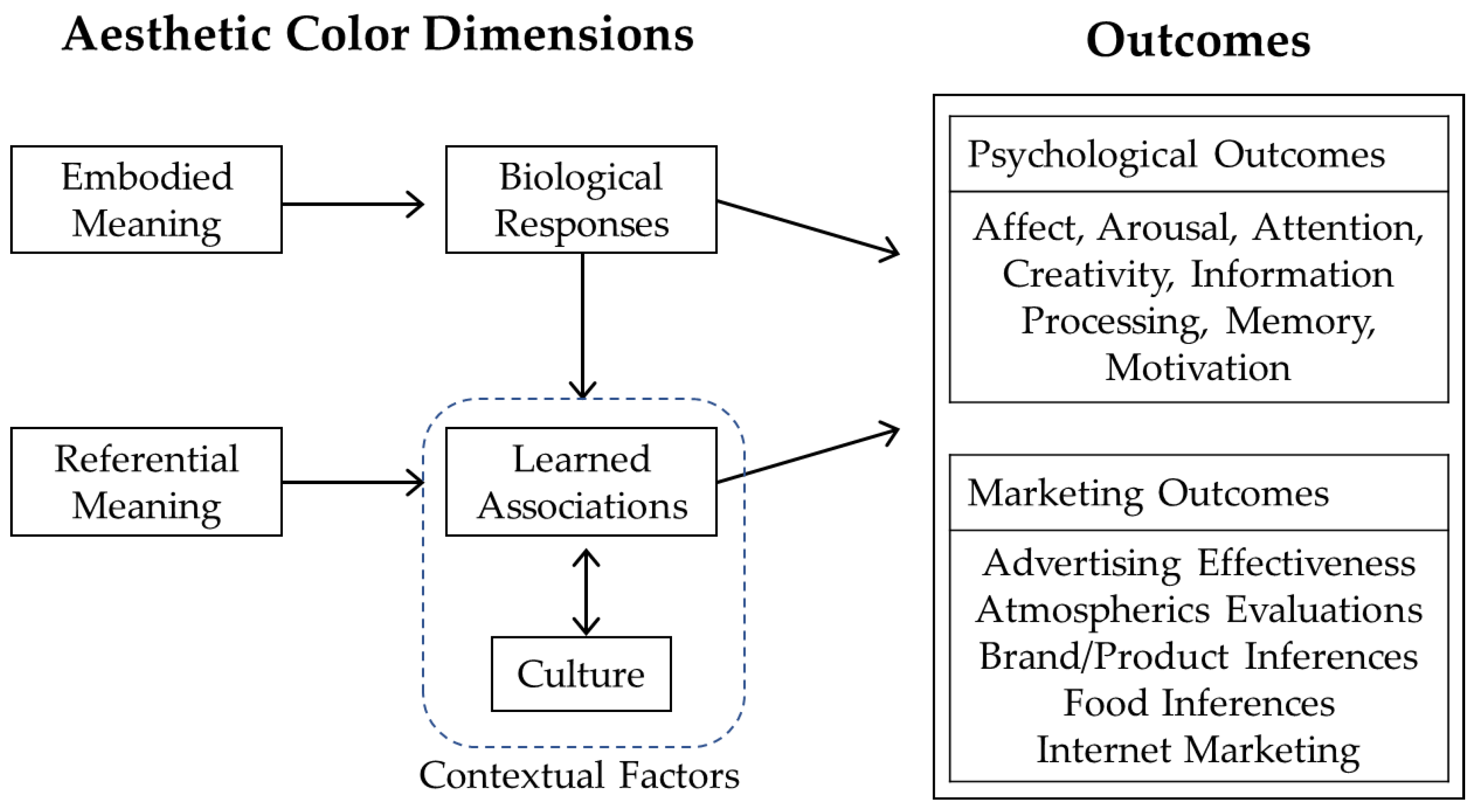
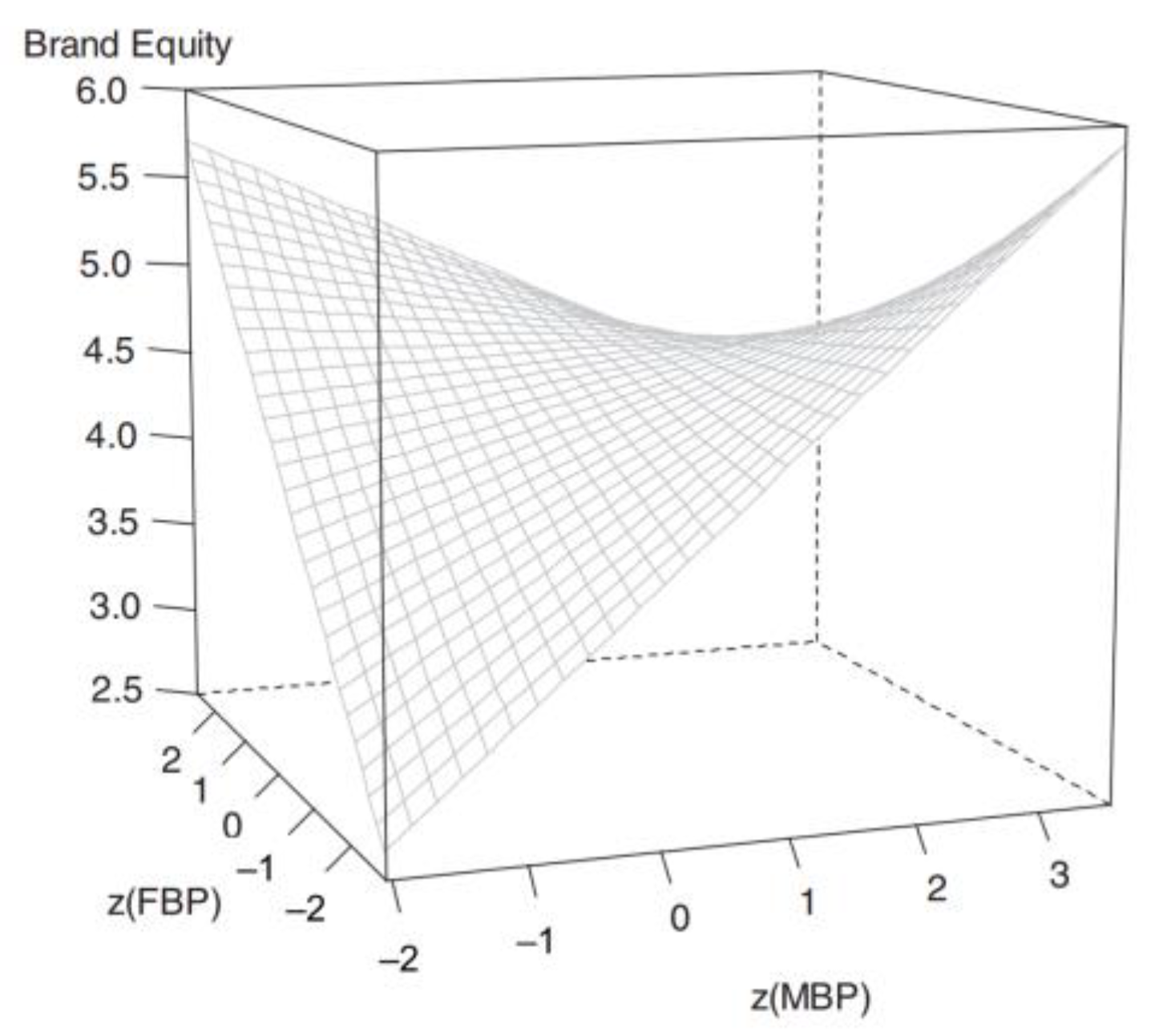

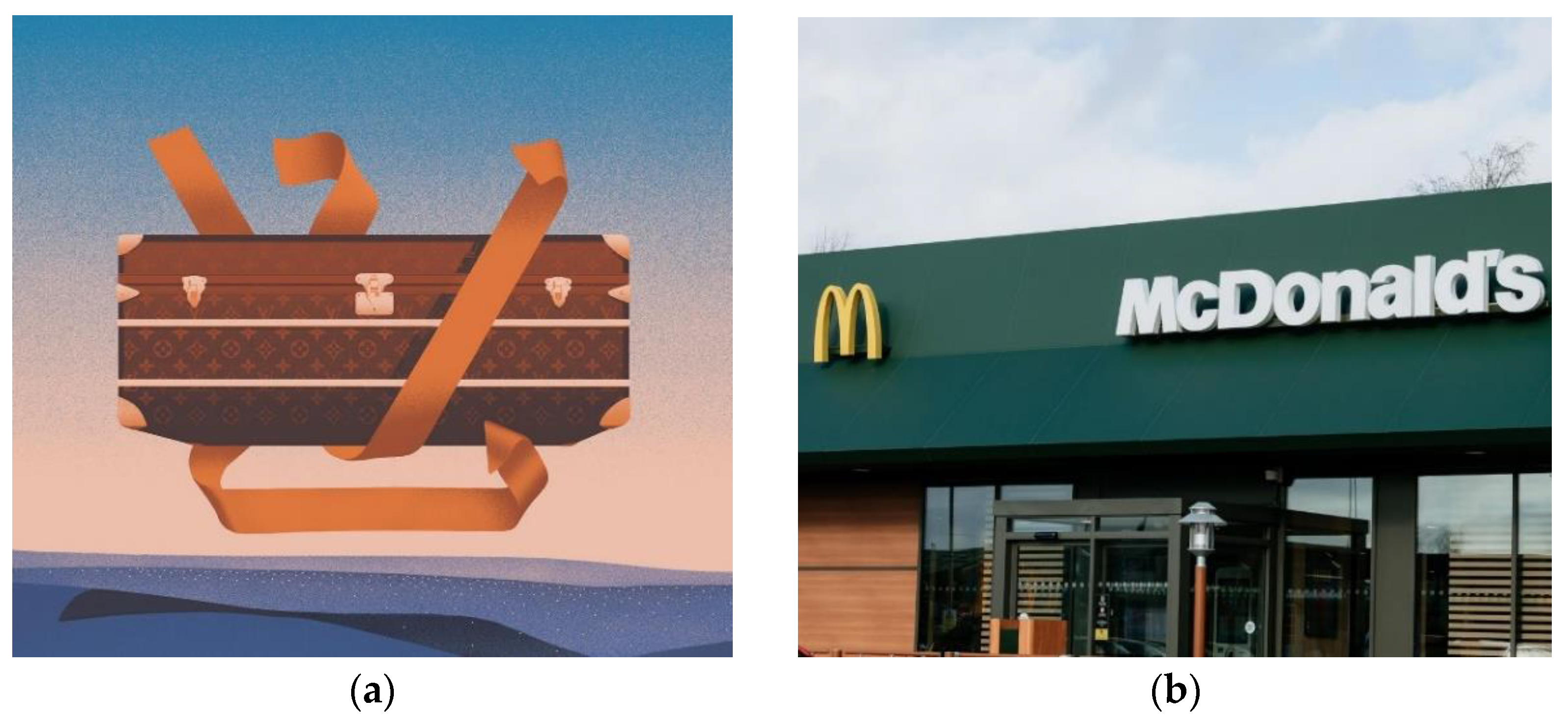
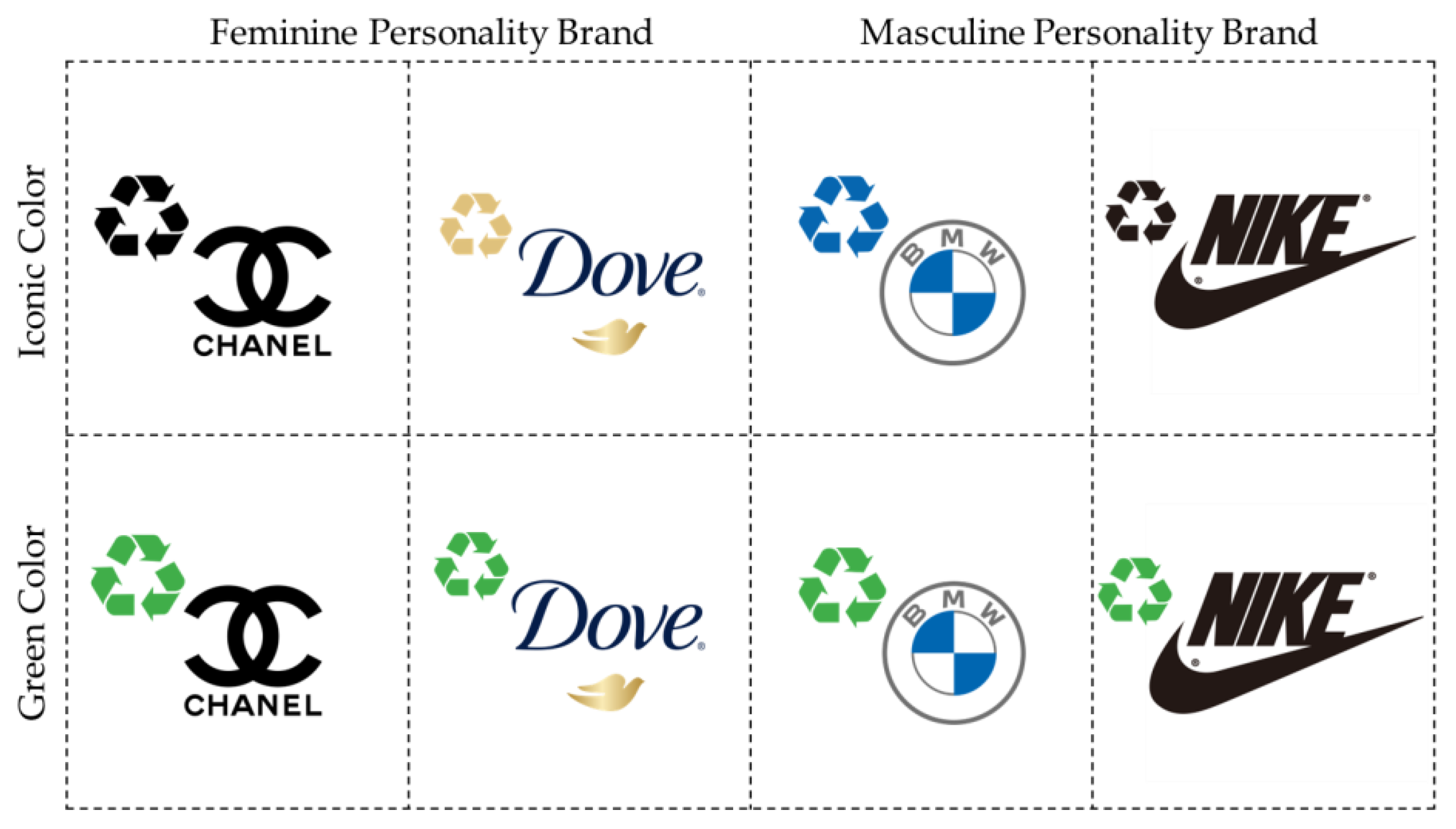
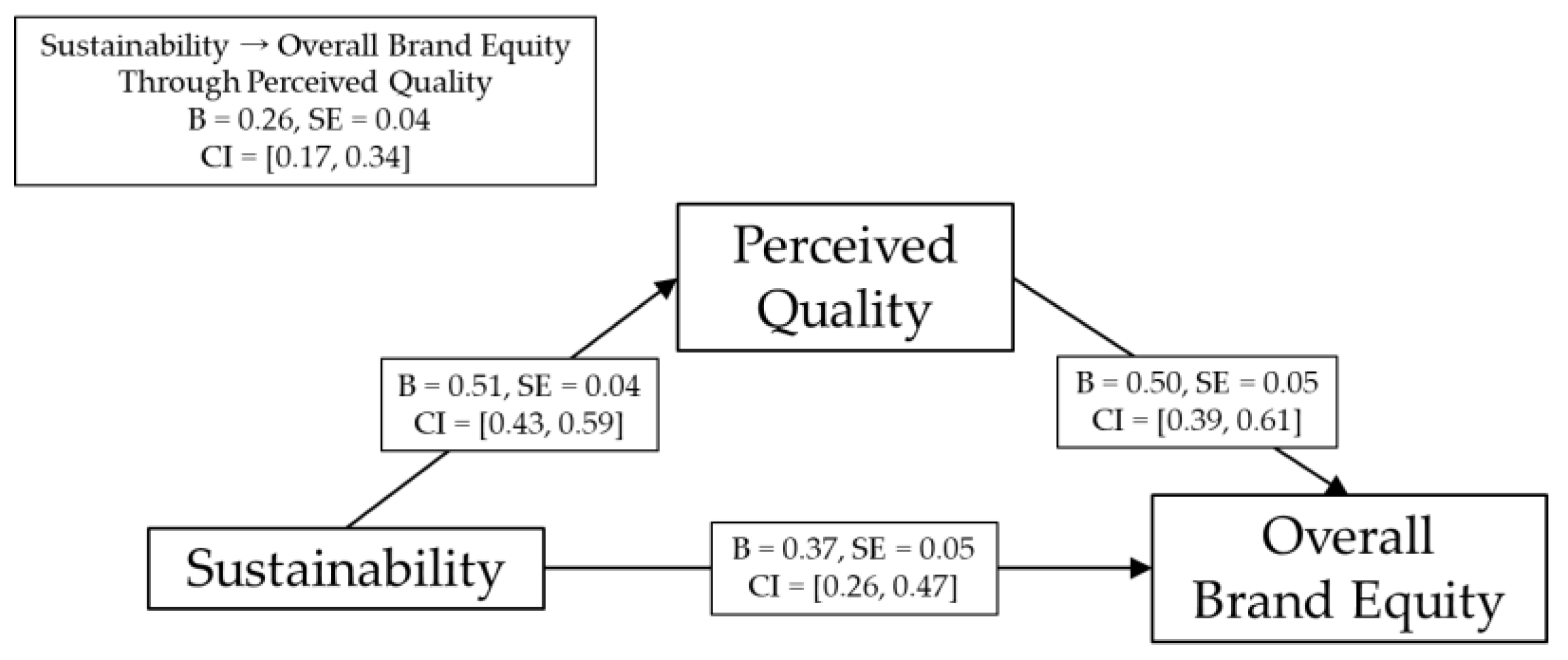
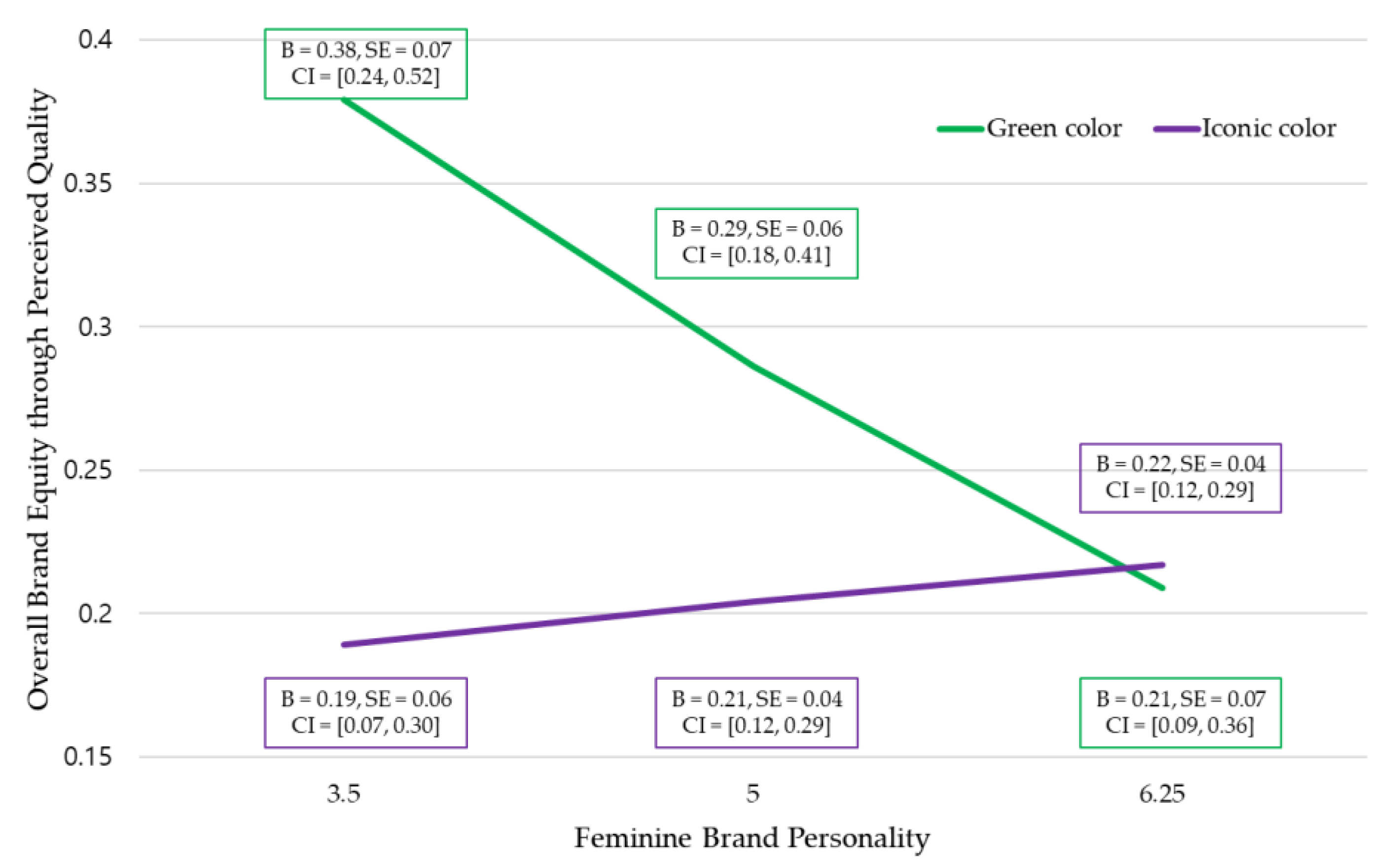

| Color | Color Attributes and Association 1 |
|---|---|
| Red | Love, passion, enthusiasm, suspension, moving, radical, turbulence, unbearable heat, fury, danger, explosion, fight, refusal, energy, vitality |
| Orange | Freshness, friendship, stamina, advance, affection, health, hope, permission, heat, warmness, passion, well-behaved, family, pleasure |
| Yellow | Inexperienced, warning behavior, pollution, joy, imperfection, glory, transportation safety, depression, contemporary culture |
| Green | Growth, rest, sincerity, health, calmness, stillness, cleanliness, mildness, cheerfulness, relaxation, vitality, safety, peace |
| Blue | Smart, cleanliness, transparency, progress, bravery, hope, admiration, silence, loneliness, quietness, justice |
| Purple | Elegance, mystery, nobility, sin, classical ritual, formality, stillness, sorrow |
| Black | Sadness, evil, crime, unlimited, shutdown, pressure, agony, regret, despair, cold-blooded |
| White | Simple, purity, freedom, innocence, future, freshness, cleanliness, peace, possibility, nothing, perfection |
| Authors (Year), Journal | Dimensions | Constructs | Research Focus |
|---|---|---|---|
| Alamsyah (2021) MSL [34] | Product | Eco-label | An examination of the relationship between green awareness, environmental knowledge, and perceived quality. |
| Perceived quality | |||
| Environmental knowledge | |||
| Green awareness | |||
| Amatulli (2021) PM [38] | Consumer Behavior | Sustainable luxury consumption | A comparison of consumer perceptions regarding sustainability-focused communication versus product excellence-focused communication in luxury products. |
| Atypicality | |||
| Sedky (2022) BSD [26] | Price | Eco-labeling | The impact of green marketing on consumers’ purchase decisions. |
| Green advertising | |||
| Price | |||
| Point of purchase | |||
| Sander (2021) JBM [39] | Promotion | Brand personality naturalness | The impact of environmental and social sustainability advertising on brand personality, credibility, and brand attitude. |
| Ad credibility | |||
| Brand attitude | |||
| Kapferer (2019) JBM [40] | Consumer Behavior | Sensitivity to sustainable luxury | The importance of understanding generational and cultural differences in sustainable luxury consumption behavior. |
| Disengagement to sustainable luxury |
| Brand Gender | Product Category | Brand | Top 100 | MBP-FBP | Iconic Color | Green Color Strategy |
|---|---|---|---|---|---|---|
| Feminine | Fashion Fragrance Cosmetics Jewelry | LV | 14 | - | - | |
| Chanel | 22 | −0.81 | - | |||
| Hermes | 23 | - | - | |||
| Gucci | 30 | - | - | |||
| Zara | 47 | −0.33 | - | |||
| Tiffany | 88 | - | - | |||
| Masculine | Food | Coca cola | 7 | 0.86 | ● | |
| McDonalds | 11 | 1.00 | ● | |||
| Pepsi | 32 | 0.34 | ● | |||
| Starbucks | 51 | 0.45 | ● | |||
| Nespresso | 67 | 0.55 | ○ | |||
| IT | Apple | 1 | 0.62 | ○ | ||
| Amazon | 3 | 0.71 | ○ | |||
| Samsung | 5 | 0.82 | ● | |||
| Sony | 39 | 0.81 | ○ | |||
| Fashion | Nike | 10 | 1.08 | ● | ||
| Adidas | 42 | 1.02 | ● |
| Variable Name | Value | Frequency | Percentage (%) |
|---|---|---|---|
| Gender | Female | 178 | 44.4 |
| Male | 223 | 55.6 | |
| Age | 20–29 years | 103 | 25.7 |
| 30–39 years | 187 | 46.6 | |
| 40–49 years | 87 | 21.7 | |
| Over 50 years | 24 | 6.0 | |
| Nationality | United States | 133 | 33.2 |
| Republic of Korea | 227 | 56.6 | |
| India | 29 | 7.3 | |
| Brazil | 10 | 2.5 | |
| United Kingdom | 1 | 0.2 | |
| Australia | 1 | 0.2 | |
| Total | 401 | 100 | |
| Measure | Definition | Measure Items |
|---|---|---|
| Sustainability Baalbaki and Guzmán (2016) [59] | Consumers’ judgment on the eco-friendliness of a brand | ST1 = Brand X is an environmentally safe brand. |
| ST2 = Brand X is an environmentally responsible brand. | ||
| ST3 = Brand X is a sustainable brand. | ||
| ST4 = Brand X is a healthy brand. | ||
| Perceived Quality Yoo et al. (2000) [44] | Consumers’ judgment of brand quality | PQ1 = Brand X is of high quality. |
| PQ2 = The likely quality of Brand X is extremely high. | ||
| PQ3 = The likelihood that Brand X would be functional is very high. | ||
| PQ4 = The likelihood that Brand X is reliable is very high. | ||
| PQ5 = Brand X must be of very good quality. | ||
| Overall brand equity Yoo et al. (2000) [44] | Consumer preference for a particular brand compared to other brands | OBE1 = It makes sense to buy X instead of any other brand, even if they are the same. |
| OBE2 = Even if another brand has same features as X, I would prefer to buy X. | ||
| OBE3 = If there is another brand as good as X, I prefer to buy X. | ||
| OBE4 = If another brand is not different from X in any way, it seems smarter to purchase X. | ||
| FBP (Feminine Brand Personality) Lieven et al. (2016) [58] | The brand personality tends to be feminine | FBP1 = Brand X is sensitive. |
| FBP2 = Brand X is graceful. | ||
| FBP3 = Brand X is expresses tender feelings. | ||
| FBP4 = Brand X is sweet. | ||
| FBP5 = Brand X is tender. | ||
| MBP (Masculine Brand Personality) Lieven et al. (2016) [58] | The brand personality tends to be masculine | MBP1 = Brand X is adventurous. |
| MBP2 = Brand X is brave. | ||
| MBP3 = Brand X is daring. | ||
| MBP4 = Brand X is dominant. | ||
| MBP5 = Brand X is sturdy. | ||
| Environmental Concern Schmuck, Matthes and Naderer (2018) [60] | Overall consumer concern for the environment | EC1 = I am concerned about the environment. |
| EC2 = The condition of the environment affects the quality of my life. | ||
| EC3 = I am willing to make sacrifices to protect the environment. |
| Constructs | Items | α | EFA | CFA | |||
|---|---|---|---|---|---|---|---|
| λ | Eigen Value | Estimate | AVE | CR | |||
| Sustainability | ST1 | 0.913 | 0.826 | 3.367 | 0.822 | 0.907 | 0.975 |
| ST2 | 0.854 | 0.835 | |||||
| ST3 | 0.808 | 0.761 | |||||
| ST4 | 0.728 | 0.769 | |||||
| Perceived quality | PQ1 | 0.936 | 0.818 | 3.905 | 0.781 | 0.905 | 0.979 |
| PQ2 | 0.837 | 0.767 | |||||
| PQ3 | 0.739 | 0.658 | |||||
| PQ4 | 0.719 | 0.780 | |||||
| PQ5 | 0.781 | 0.840 | |||||
| Overall brand equity | OBE1 | 0.928 | 0.714 | 3.102 | 0.755 | 0.890 | 0.970 |
| OBE2 | 0.810 | 0.858 | |||||
| OBE3 | 0.724 | 0.844 | |||||
| OBE4 | 0.739 | 0.870 | |||||
| Feminine brand personality | FBP1 | 0.857 | 0.558 | 3.312 | 0.849 | 0.864 | 0.969 |
| FBP2 | 0.767 | 0.642 | |||||
| FBP3 | 0.854 | 0.830 | |||||
| FBP4 | 0.773 | 0.818 | |||||
| FBP5 | 0.825 | 0.850 | |||||
| Masculine brand personality | MBP1 | 0.867 | 0.861 | 4.158 | 0.837 | 0.873 | 0.972 |
| MBP2 | 0.880 | 0.839 | |||||
| MBP3 | 0.885 | 0.841 | |||||
| MBP4 | 0.719 | 0.733 | |||||
| MBP5 | 0.766 | 0.776 | |||||
| Environmental concern | EC1 | 0.782 | 0.815 | 2.105 | 0.838 | 0.837 | 0.937 |
| EC2 | 0.808 | 0.526 | |||||
| EC3 | 0.711 | 0.807 | |||||
| Goodness of fit indices: Normed χ2 = 1.486, CFI = 0.954, GFI = 0.847, AGFI = 0.811, RMR = 0.080, RMSEA = 0.053 | |||||||
| ST | PQ | OBE | FBP | MBP | EC | AW | |
|---|---|---|---|---|---|---|---|
| ST | 0.952 | ||||||
| PQ | 0.606 ** | 0.951 | |||||
| OBE | 0.613 ** | 0.666 ** | 0.943 | ||||
| FBP | 0.373 ** | 0.350 ** | 0.420 ** | 0.929 | |||
| MBP | 0.318 ** | 0.474 ** | 0.470 ** | 0.160 ** | 0.934 | ||
| EC | 0.337 ** | 0.405 ** | 0.435 ** | 0.371 ** | 0.246 ** | 0.915 | |
| AW | 0.244 ** | 0.291 ** | 0.272 ** | 0.269 ** | 0.294 ** | 0.368 ** | - |
| Mean | 5.366 | 5.462 | 4.959 | 4.923 | 5.192 | 5.411 | 6.067 |
| S.D. | 1.172 | 1.162 | 1.411 | 1.373 | 1.407 | 1.139 | 1.254 |
Disclaimer/Publisher’s Note: The statements, opinions and data contained in all publications are solely those of the individual author(s) and contributor(s) and not of MDPI and/or the editor(s). MDPI and/or the editor(s) disclaim responsibility for any injury to people or property resulting from any ideas, methods, instructions or products referred to in the content. |
© 2023 by the authors. Licensee MDPI, Basel, Switzerland. This article is an open access article distributed under the terms and conditions of the Creative Commons Attribution (CC BY) license (https://creativecommons.org/licenses/by/4.0/).
Share and Cite
Sun, M.; Kim, J. Sustainability and Brand Equity: The Moderating Role of Brand Color and Brand Gender. Sustainability 2023, 15, 8908. https://doi.org/10.3390/su15118908
Sun M, Kim J. Sustainability and Brand Equity: The Moderating Role of Brand Color and Brand Gender. Sustainability. 2023; 15(11):8908. https://doi.org/10.3390/su15118908
Chicago/Turabian StyleSun, Minjae, and Joonseok Kim. 2023. "Sustainability and Brand Equity: The Moderating Role of Brand Color and Brand Gender" Sustainability 15, no. 11: 8908. https://doi.org/10.3390/su15118908
APA StyleSun, M., & Kim, J. (2023). Sustainability and Brand Equity: The Moderating Role of Brand Color and Brand Gender. Sustainability, 15(11), 8908. https://doi.org/10.3390/su15118908





